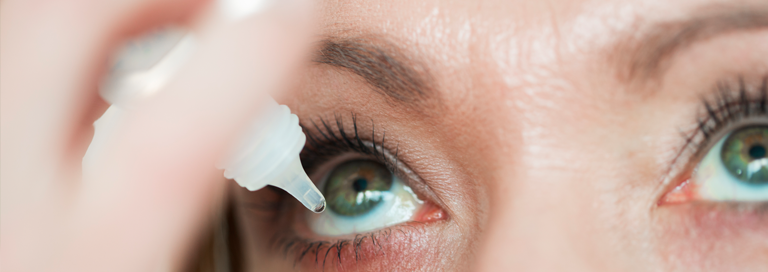
Along with the hot flashes, moodiness, and vaginal dryness associated with menopause, there is another symptom that affects 62% of all menopausal women.1
And mainstream medicine has no idea that it’s connected to your hormones…
I’m talking about dry eye syndrome.
Dry eye syndrome is more than just annoying. Inflammation causes your eyes to become red, itchy, and swollen. It’s a potentially serious condition that can result in an infection. And, in some cases, it can permanently damage your vision.
Most women with dry, itchy, irritated eyes treat themselves with “artificial tears.” While this can give you temporary relief, using eye drops is just treating the symptom. It never gets to the real cause of dry eyes — the out-of-whack balance between your sex hormones, estrogen and testosterone.
Research shows that your cornea as well as your tear ducts (the meibomian glands) have testosterone and estrogen receptors.2
And because women over the age of 60 have higher estrogen levels, this leads to fewer tears.3
As a regular reader, you know that menopausal women are especially prone to estrogen dominance. This dominance is the direct result of what I call “alien estrogens.”
These hormone-disrupting chemicals are everywhere. They’re in your food and drink cans, water bottles, beauty products, and electronics. They’re even in your eyeglasses!
One way to help remedy your dry eyes is to restore a natural balance among estrogen, progesterone, and testosterone. Here at the Sears Institute for Anti-Aging Medicine, I’ve helped thousands of women get back in balance using bioidentical hormones.
I start by measuring estrogen, progesterone, and testosterone levels in the blood. You see, hormone levels vary widely among women. Then, I write a prescription that you take to a compounding pharmacist who gives you exactly what you need. For more on safe, effective, and natural menopause relief.
But before you do, I want to share the best way to lubricate dry eyes – whether you’re in menopause or not.
I’m talking about how a diet high in healthy omega-3 fats can lubricate dry eyes by lowering inflammation and increasing the eye’s oily film in your tear ducts. This helps provide natural lubrication instead of the temporary “artificial” relief from eye drops.
Studies show eating more fish reduces the risk of dry eye syndrome. In a Harvard study, women who ate five servings of tuna a week had a 68% reduced risk of dry eyes compared to women who ate one serving.4
Fish supports eye health because it is high in omega-3 fatty acids. Research shows that supplementing with omega-3 fatty acids can improve dry eye symptoms by 65%.5
Oily fish like salmon, tuna, herring, sardines, and trout are best. But, buy wild-caught fish. The farmed versions have very few omega-3s.
You can also supplement. But avoid fish oil. Most fish oil comes from polluted waters that contain chemicals like PCBs and heavy metals like mercury. This is worse than not taking a supplement in the first place.
Here’s what I recommend you look for instead…
Choose The Right Omega-3 To Restore Dry Eyes
- Take this tiny animal oil instead. Krill are shrimp-like animals that don’t live long enough to absorb large amounts of toxins — so they don’t get contaminated. And their omega-3s are stored in a phospholipid form instead of triglycerides. This helps them pass through the cell membranes better.
- And combine it with calamari. But make sure your calamari oil comes from squid that live off the coast of South America in the pure waters of the South Pacific (illex argentinus).
- Check the label. Make sure your omega-3 has 600 mg of DHA and 400 mg of EPA. Calamari has one of the highest concentrations of DHA than any food.
- Add in some astaxanthin. Studies show astaxanthin increases blood flow throughout the eye. It has the power to soothe and protect the deepest parts of your eye, including the retina.6 It also helps relieve dry eyes, double vision, and blurring. Take 10 mg a day.
To Your Good Health,

Al Sears, MD, CNS
1. Roch E, et al. “Hormones and dry eye syndrome: an update on what we do and don’t know.” Curr Opin Ophthalmol. 2013;24(4):348-355.
2.Versura P, et al. “Sex-steroid imbalance in females and dry eye.” Current Eye Research. 2015;40:2, 162-175.
3. Mathers WD, et al. “Menopause and tear function: the influence of prolactin and sex hormones on human tear production.” Cornea. 1998; 17:353–358.
4. “Dietary fat intake linked to dry eye syndrome in women.” Harvard Gazette. 2005. Accessed May 31, 2021.
5. Bhargava R, et al. “A randomized controlled trial of omega-3 fatty acids in dry eye syndrome.” Int J Ophthalmol. 2013;6(6):811-816.
6. Cort A, et al. “Suppressive effect of astaxanthin on retinal injury induced by elevated intraocular pressure.” Regul Toxicol Pharmacol. 2010;58(1):121-130.








